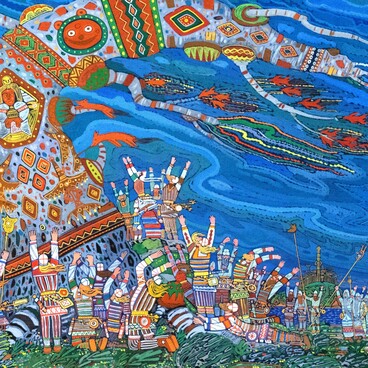In the 1990s, after the collapse of the Soviet Union, the issues of faith and spiritual search once again became relevant in Russia. New religious organizations and houses of worship appeared in the Komi Republic. People became interested in the history of religion and its key personalities, while artists created a series of works dedicated to these subjects.
Orthodoxy came to the Komi lands in the 14th century, gradually replacing paganism. Stephen of Perm, a bishop of the Russian Orthodox Church, began baptizing the Komi-Permyaks. He also created the first alphabet of the Great Perm. The Zyryan alphabet was based on the local writing system using carved notches and the letters of Greek, Slavic, and Old Turkic languages.
Stephen of Perm translated the Bible and other Christian books for the Komi-Permyaks, built Orthodox churches, and painted the first icons. His icon titled “The Zyryan Trinity” has survived to this day. The bishop converted the majority of the local population to Christianity and was canonized as a saint.
There are many legends associated with the name of Stephen of Perm. He is believed to have fought against local sorcerers, confronted Kört-Aika, walked on water on a stone raft, and passed through a burning hut and under the ice of the Vychegda River. Particularly notable is the legend of the Indomitable Birch, a mysterious “living idol”. It used to grow on a high hill. Pagans used to make fires around the tree and smear it with sacrificial blood. While burning down the wooden temples of the Permyaks, Stephen of Perm decided to chop down the Indomitable Birch as well.
Legend has it that after the bishop first struck the birch with an ax, thick black blood poured out of the tree, and hundreds of voices cried out for mercy. The bishop kept hacking at the tree all day long but could not fell it. When he returned in the morning, the birch was found perfectly intact. It kept happening for two more days until eventually, on the evening of the third day, Stephen of Perm felled down the sacred tree which immediately turned into ashes.
The granite monument to Stephen of Perm was
designed by the sculptor Vladislav Mamchenko. A resident of blockade Leningrad
and a graduate of the Mukhina School of Art, he became one of the founders of
urban Komi sculpture. Mamchenko created a number of Syktyvkar landmarks,
including a monument to Ivan Kuratov in front of the Komi Republic State Opera
and Ballet Theater, the “Immortal Glory” memorial, as well as portraits of
Dmitri Shostakovich, the director Ivan Abramov, and the poet Viktor Kushmanov.








